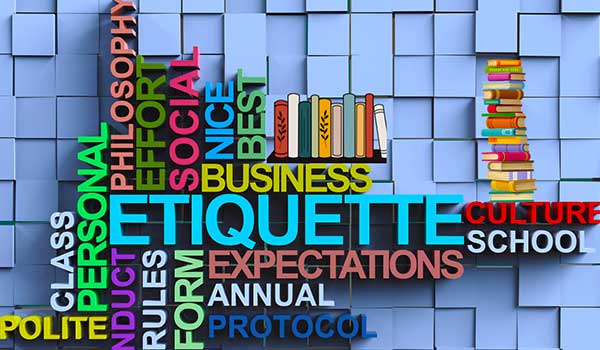
Greetings, graceful readers and seekers of social savoir-faire! Whether you’re looking to polish your poise, finesse your formalities, or simply face social situations with more confidence, you’ve arrived at the perfect destination. Etiquette refers to conventional rules and norms governing social behavior and interactions in a particular society or culture. It covers a range of guidelines and expectations for how anyone should conduct themselves in various social settings.
Etiquette includes manners, customs, and practices that promote respectful, considerate, and polite behavior. One famous etiquette expert is Emily Post (1872-1960), an American author and socialite who became widely known for her expertise in etiquette and manners. She authored the book “Etiquette: In Society, in Business, in Politics, and at Home,” which was first published in 1922 and became a definitive guide on social conduct.
We’ll learn about etiquette and manners through the pages of Books, where the art of politeness and the wisdom of gracious living are celebrated and explored. From timeless traditions to modern manners, these guides offer pearls of wisdom for every occasion, ensuring you’re well-equipped to shine in society with elegance and ease. So, if you’re ready to elevate your etiquette and master the subtleties of sophisticated interaction, let’s turn the page and discover the keys to unlocking a world of respectful, courteous, and charming engagements.
10 Self-Help Books About Etiquette And Manners
Books about etiquette guide how to behave in social interactions with grace and confidence. They offer practical tips and insights into proper behavior, conversation etiquette, and social norms, helping you develop essential social skills that benefit you in various personal and professional settings. Understanding and practicing etiquette can also boost your self-confidence. This confidence positively impacts your personal and professional relationships.
Moreover, Etiquette promotes positive and respectful communication, fostering stronger relationships with family, friends, colleagues, and acquaintances. I will talk about ten books on etiquette and manners. They encourage self-reflection and cultivate kindness, empathy, and respect. Also, these books address cultural differences and customs, helping you survive diverse social environments and demonstrate respect for other cultures. Let’s learn!
1. Emily Post’s Etiquette by Peggy Post
Emily Post’s Etiquette is a well-regarded classic book that provides comprehensive guidance on modern etiquette. Peggy Post, the great-granddaughter-in-law of Emily Post, took over the responsibility of updating and continuing the iconic book series that was originally authored by Emily Post.
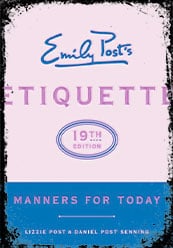
This book covers many topics related to social etiquette, manners, and proper conduct in various settings. It offers advice on social interactions, communication skills, dress codes, table manners, wedding etiquette, business etiquette, and more. The author addresses contemporary issues while also maintaining the timeless principles of etiquette.
This nonfiction self-help book is a reliable reference for facing modern social situations with poise and grace. It guides handling different scenarios, avoiding common etiquette pitfalls, and fostering positive relationships. The book aims to help struggle with social complexities, build stronger connections, and present themselves with confidence in different aspects of their lives. It is widely available in bookstores, libraries, and online retailers if you want to learn more about etiquette and enhance your social skills.
Key points:
- A comprehensive guidance on modern manners and proper behavior.
- Social situations, including dining etiquette, communication skills, and professional conduct.
- Practical advice for facing contemporary etiquette dilemmas with grace and confidence.
- Emphasize the importance of respect, consideration, and kindness in interpersonal interactions.
- A trusted resource for people seeking to handle social complexities and build positive relationships.
2. Miss Manners’ Guide to Excruciatingly Correct Behavior by Judith Martin
Miss Manners’ Guide to Excruciatingly Correct Behavior” is a comprehensive guidebook that provides valuable insights and practical advice on driving the intricacies of modern etiquette. Judith Martin is widely known as Miss Manners, who brings her signature mix of wit, humor, and wisdom to social behavior.
The resourceful book covers various topics, from everyday interactions to formal events, addressing social dilemmas with grace and practicality. Martin’s writing style is engaging and entertaining, making the exploration of etiquette a delightful experience.
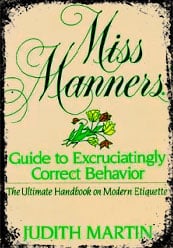
One of the book’s strengths is its ability to adapt timeless principles of etiquette to the ever-changing landscape of contemporary society. Martin acknowledges the shifts in social norms and technology’s influence on communication, guiding how to face these new challenges while upholding respect and consideration for others.
She emphasizes the importance of etiquette in fostering positive relationships, maintaining social harmony, and demonstrating kindness and consideration. It reminds us that etiquette is not about rigid rules or snobbery but rather a means to show respect, empathy, and civility toward others.
You can easily handle different sections or refer to specific chapters based on their areas of interest or specific social situations you need guidance on. I recommend it if you want timeless principles and contemporary guidance to handle any situation gracefully.
Key points:
- A practical guide to handling modern etiquette.
- Covers various topics, including social interactions, communication etiquette, and proper conduct in various situations.
- Many insightful advice on handling contemporary etiquette dilemmas with grace and humor.
- The importance of etiquette in fostering positive relationships and maintaining social harmony.
- Provide timeless principles and guidelines for struggling with social complexities with tact, consideration, and respect.
3. The Amy Vanderbilt Complete Book of Etiquette by Nancy Tuckerman and Nancy Dunnan
The Amy Vanderbilt Complete Book of Etiquette guide covers etiquette and proper behavior in various social situations. Originally written by Amy Vanderbilt, this updated edition by Nancy Tuckerman and Nancy Dunnan remains a trusted resource for seeking guidance on modern manners.
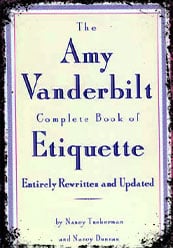
The book shows all aspects of etiquette, from introductions and greetings to table manners, personal grooming, communication skills, and social events. It provides detailed advice on appropriate behavior in formal and informal settings, including home, workplace, and public spaces.
One of the strengths of this book is its attention to detail and the extensive coverage of different scenarios. It offers practical guidance on facing complex social interactions, handling tricky situations gracefully, and displaying thoughtfulness and respect towards others.
The authors address the changing landscape of modern society, considering new technologies, communication methods, and cultural diversity. It recognizes the importance of adapting traditional etiquette principles to the realities of contemporary life while emphasizing the enduring value of courtesy, consideration, and respect.
The writing style is clear, concise, and easy to follow. The information is presented well-organized, allowing you to find relevant advice or refer back to specific topics quickly. While the book may be perceived as somewhat traditional in certain aspects, it strikes a balance between timeless etiquette principles and the evolving social landscape.
Pick this book if you are a beginner and want to learn etiquette from a starting point. That’s because it provides a strong foundation for understanding and practicing good manners while acknowledging the need for flexibility and open-mindedness in today’s world.
Key points:
- Comprehensive guidance on proper behavior in various social situations.
- Introductions, table manners, communication skills, and social events.
- Practical advice on navigating complex social interactions with grace, respect, and consideration for others.
- Modern technological changes, cultural diversity, and evolving social norms emphasize the enduring values of courtesy and respect.
- A reliable resource for seeking to solve social complexities and practice good manners in today’s world.
4. A Gentleman in Moscow by Amor Towles
A Gentleman in Moscow is a literary fiction that won the Goodreads Choice Award nomination for Best Historical Fiction. It tells the captivating story of Count Alexander Rostov, an aristocrat placed under house arrest in the luxurious Metropol Hotel in Moscow in 1922. The story unfolds in post-revolutionary Russia, where the Count is sentenced to live his days confined to the Metropol Hotel.
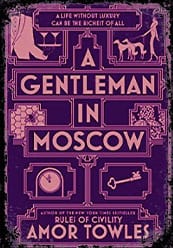
Towles’ writing style is elegant, capturing the essence of the time and place with rich descriptions and meticulous attention to detail. Through skillful storytelling, he paints a vivid picture of the opulent hotel and its colorful characters.
At its core, the novel is a character study focusing on the Count’s resilience, adaptability, and unwavering commitment to maintaining his dignity and a sense of purpose in adversity. Through his interactions with hotel staff, guests, and a young girl named Nina, the Count faces the constraints of his confined existence with grace and charm.
Throughout the novel, the Count converses with fellow guests and acquaintances. His conversations demonstrate his intellectual curiosity, eloquence, and ability to navigate different topics with tact and wit, which are valued elements of social etiquette. It is a testament to the power of literature to illuminate the human experience and celebrate the triumph of the human spirit.
- Resilience, friendship, and the power of human connection against a changing political landscape.
- The enduring qualities of grace, dignity, and kindness, even in adversity.
5. The Art of Civilized Conversation: A Guide to Expressing Yourself with Style and Grace by Margaret Shepherd
The Art of Civilized Conversation is a valuable guide that offers insights and practical advice on engaging in meaningful conversations with style and grace. With a focus on fostering authentic connections and effective communication, Shepherd provides us with tools to navigate social interactions confidently and tactfully. The book emphasizes the importance of active listening and empathy.
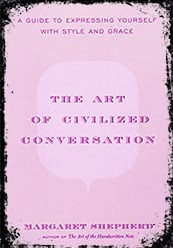
Shepherd highlights the significance of truly hearing and understanding others, encouraging readers to ask thoughtful questions and engage in meaningful dialogue. She guides being present in conversations, showing respect and genuine interest in what others say.
The book covers various topics, including initiating conversations, etiquette, maintaining engaging dialogue, and resolving conflicts. Shepherd offers tips on navigating sensitive subjects, handling awkward moments, and expressing oneself effectively while remaining considerate of others.
She presents her insights in a practical and relatable manner, providing relatable examples and exercises to improve conversational skills. Her warm and encouraging tone creates a welcoming atmosphere, making the book feel like a friendly conversation rather than rigid rules.
This self-help book also addresses the role of technology and social media in modern communication. The author explores the challenges and opportunities presented by these platforms and offers suggestions on how to maintain etiquette and meaningful connections in the digital age. Anyone seeking to enhance their conversational skills and build stronger connections with others will love it.
Key points:
- Guidance on engaging in meaningful conversations with style and grace.
- Active listening, thoughtful questioning, and authentic engagement create meaningful connections.
- Practical tips on driving sensitive topics, resolving conflicts, and expressing oneself effectively.
- The importance of empathy, respect, and open-mindedness in communication.
- The art of conversation with confidence, poise, and consideration for others.
6. Modern Manners: The Essential Guide to Correct Behaviour and Etiquette by Dorothea Johnson and Liv Tyler
Modern Manners is a contemporary guidebook offering practical advice on facing modern social situations gracefully and confidently. It provides a valuable resource for individuals struggling with the complexities of social interactions in the modern world.
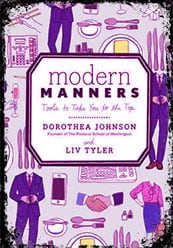
Dorothea Johnson is an etiquette expert, and Liv Tyler is an actress passionate about etiquette. So, the book offers a unique blend of expertise and relatability. It acknowledges the changing dynamics of social norms, communication methods, and cultural diversity.
Johnson and Tyler guide how to adapt traditional etiquette principles to the realities of today’s society, ensuring that readers feel equipped to drive a wide range of social scenarios. The book covers introductions, greetings, communication etiquette, table manners, dress codes, and hosting or attending social events.
It features practical tips and insights on proper behavior in various settings, from the workplace to formal occasions and everyday encounters. The authors present their advice in a friendly and conversational manner, making it relatable and enjoyable to read. Including personal anecdotes and stories adds a personal touch and enhances the reading experience.
Key points:
- Practical advice for navigating modern social situations with grace and confidence.
- Traditional etiquette principles with contemporary insights, helping readers adapt to changing social norms and cultural diversity.
- Cultural awareness and inclusivity, providing insights on handling cross-cultural interactions with sensitivity and respect.
7. The Polite Gentlemen’s Guide to Proper Etiquette: A Complete Guide for a Gentleman’s Conduct by Cecil B. Hartley
The Polite Gentlemen’s Guide to Proper Etiquette is a timeless guide that offers valuable insights and advice on proper behavior and manners specifically for gentlemen. Originally published in 1860, this book provides a fascinating window into the social norms and expectations of the Victorian era.
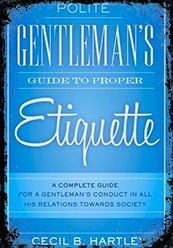
Hartley’s writing style reflects the formality and etiquette standards of the time. He covers various topics relevant to gentlemen, including introductions, proper dress, conversation etiquette, hosting and attending social events, chivalry, and gentlemanly conduct in various situations.
The attention to detail emphasizes etiquette to display respect, refinement, and consideration for others. Hartley provides specific guidelines and rules to guide gentlemen on how to comport themselves in different settings to maintain decorum and uphold societal expectations.
This book reflects the social norms and expectations of the 19th century and may not align with contemporary perspectives or gender equality principles. The advice provided should be viewed historically, considering the time it was written. For readers interested in historical etiquette and the customs of the Victorian era, it offers a valuable glimpse into the social expectations and behaviors of the time.
Key Points:
- A guide to etiquette specifically tailored for gentlemen, covering various aspects of behavior, manners, and conduct.
- Introductions, proper dress, conversation etiquette, hosting and attending social events, and chivalry.
- The importance of displaying respect, refinement, and consideration for others to maintain decorum and uphold societal expectations.
- A window into the etiquette standards of the Victorian era.
8. Social Q’s: How to Survive the Quirks, Quandaries, and Quagmires of Today by Philip Galanes
Social Q’s is a contemporary etiquette book that offers practical advice for surviving modern social dilemmas and challenges. The book covers more challenging situations, focusing on practical solutions and thoughtful guidance. Galanes addresses issues related to technology, social media, workplace dynamics, relationships, and various social contexts. He offers insights on how to behave in these modern challenges while maintaining respect, empathy, and consideration for others.
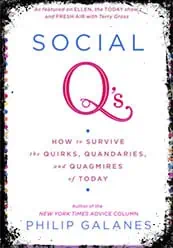
Galanes’ writing style is engaging and humorous, making the book enjoyable. He uses real-life scenarios and reader-submitted questions to provide relatable examples and practical advice. His approach is empathetic and non-judgmental, recognizing that social situations can be nuanced and offering suggestions that promote kindness, open communication, and conflict resolution. Each chapter addresses a different theme or scenario, allowing us to access relevant information when needed quickly.
Key points:
- Practical advice on surviving modern social dilemmas and challenges with grace.
- Technology, workplace dynamics, relationships, and communication etiquette.
- Solutions, guidance, kindness, open communication, and conflict resolution.
- Self-reflection, personal growth, and accountability for actions and words.
- Empathy, inclusivity, and embracing diversity to create more respectful and harmonious social environments.
9. The Little Book of Etiquette: A Personal Approach to Social Skills by Dorothea Johnson
The Little Book of Etiquette is a concise guide that offers practical advice and a personal approach to mastering social skills and etiquette. Dorothea Johnson is an expert in etiquette and manners. She distills essential principles of etiquette into a concise and accessible format.
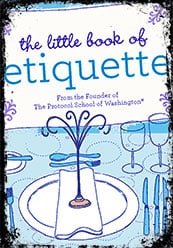
The book shares her insights and experiences, offering a relatable perspective that encourages readers to develop their style of etiquette. She emphasizes the importance of authenticity and being true to oneself while still adhering to the principles of good manners.
Each chapter provides practical tips and techniques to survive different scenarios, empowering us to feel comfortable and confident in various social settings. Johnson acknowledges the impact of technology, social media, and cultural diversity on social interactions, guiding how to adapt traditional etiquette principles to contemporary circumstances.
- A concise guide to mastering social skills and etiquette with a personal touch.
- The importance of authenticity and being true to oneself while adhering to the principles of good manners.
- Conversation skills, table manners, attire, and hosting or attending social events.
- Practical tips and techniques to handle different social scenarios, empowering readers to feel comfortable and confident.
- Promotes kindness, respect, and consideration for others as the foundation for creating positive social interactions.
10. The Ladies’ Book of Etiquette and Manual of Politeness: A Complete Hand Book for the Use of the Lady in Polite Society by Florence Hartley
The Ladies’ Book of Etiquette is a nonfiction old guidebook that provides valuable insights into the social expectations and manners of the Victorian era. Florence Hartley’s book reflects the social norms and expectations of the 19th century, specifically tailored for women in polite society. It offers a fascinating glimpse into the etiquette standards of the Victorian era, capturing the emphasis placed on refinement, grace, and elegance.
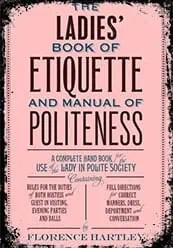
One of the book’s strengths is its thorough coverage of various aspects of etiquette. It serves as a comprehensive handbook for women seeking to face the complexities of social interactions in that era. Hartley offers practical advice and specific rules to follow, helping us face the intricacies of social conduct in a society where proper behavior is significant.
This etiquette book for Ladies reflects the values and customs of a specific time and place and may not align with contemporary perspectives or gender equality principles. You should approach the book with a historical lens, recognizing that societal norms have evolved since its publication in the 1860s.
Key points:
- Detailed guidance on etiquette and proper conduct, offering insights and rules for women to navigate polite society.
- The importance of cultivating refinement, grace, and elegance as essential qualities for women in polite society.
- The social norms and expectations of the time it was written (1860s) showcase the etiquette standards of the Victorian era.
The rules of etiquette
Etiquette surrounds a set of guidelines and principles that govern social behavior and interactions. While specific rules may vary depending on cultural, regional, and individual preferences, here are some general principles and areas that etiquette covers:
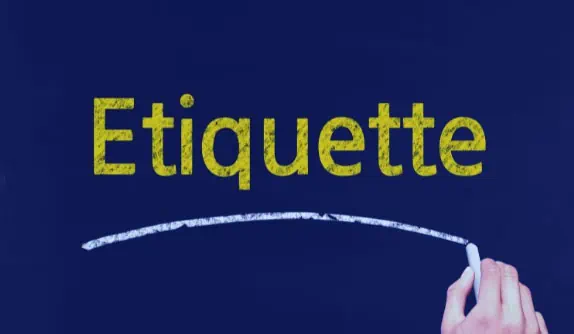
Respect and Consideration: Etiquette emphasizes treating others with kindness and consideration. This includes using polite language, listening actively, and valuing others’ opinions.
Introductions and Greetings: Etiquette guides proper introductions, including initiating introductions, making eye contact, offering a firm handshake, and using appropriate titles or honorifics.
Communication: Etiquette focuses on effective and respectful communication. This includes active listening, maintaining appropriate eye contact, avoiding interrupting others, and using polite and considerate language.
Table Manners: Dining etiquette covers proper behavior at the table, such as using utensils correctly, chewing with your mouth closed, waiting for others to begin eating before starting, and engaging in polite conversation.
Dress Code: Etiquette includes adhering to dress codes appropriate for different occasions. It involves dressing modestly, considering the event’s formality, and respecting cultural norms.
Social Events: Etiquette provides guidelines for attending social events. It includes responding promptly to invitations, being punctual, conversing politely, and expressing gratitude to hosts.
Technology Etiquette: With the rise of technology, etiquette extends to digital communication. This includes using appropriate language, refraining from excessive device usage in social settings, and respecting others’ privacy and boundaries online.
Gift Giving: Etiquette guides proper gift-giving practices, such as selecting thoughtful gifts, expressing gratitude for received gifts, and considering cultural norms or personal preferences.
Workplace Etiquette: Etiquette includes being respectful to colleagues, following professional codes of conduct, using appropriate language and tone, and demonstrating punctuality and reliability.
Travel Etiquette: Etiquette extends to travel situations, including respecting fellow travelers, adhering to transportation rules, and respecting local customs and cultures.
Etiquette is a set of guidelines to promote respectful and considerate behavior, but it can adapt to changing social norms and cultural contexts.
What are the 10 etiquettes?
While the specific etiquettes can vary based on cultural, regional, and situational factors, here are ten commonly recognized etiquette:
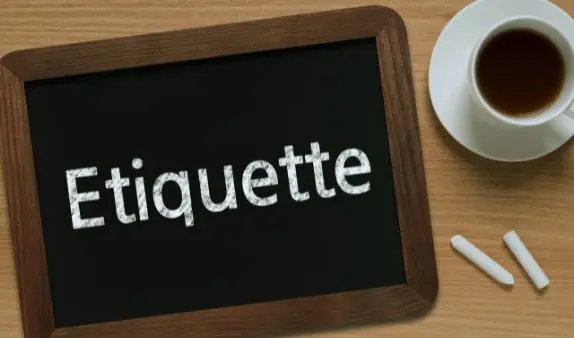
Greetings: Properly greeting others is an essential etiquette, including using appropriate words, making eye contact, and offering a handshake or other culturally accepted gestures.
Introductions: Knowing how to introduce people to one another is essential. Etiquette guides introduce others using their names, titles, or appropriate honorifics, making each person feel welcome.
Active Listening: Etiquette emphasizes the importance of active listening. It involves giving full attention, maintaining eye contact, and avoiding interrupting others while speaking.
Dining Etiquette: Table manners are a significant aspect of etiquette. This includes using utensils correctly, chewing with your mouth closed, waiting for others to begin eating before starting, and engaging in polite conversation during meals.
Polite Language: Using polite and considerate language is a fundamental etiquette principle. This involves using “please” and “thank you,” speaking respectfully to others, and avoiding offensive or inappropriate language.
Respect Personal Space: Etiquette encourages respecting personal space and boundaries. It involves maintaining an appropriate physical distance, refraining from touching others without consent, and being aware of cultural norms.
Punctuality: Being punctual demonstrates respect for others’ time. Etiquette emphasizes arriving on time for appointments, meetings, and social events or communicating promptly if delays are unavoidable.
Proper Attire: Dressing appropriately for different occasions is an etiquette guideline. It involves adhering to dress codes, considering the event’s formality, and respecting cultural or religious customs.
Gratitude and Appreciation: Demonstrating gratitude and appreciation is a vital etiquette principle. This includes expressing thanks when receiving compliments, gifts, or acts of kindness and showing appreciation for others’ efforts or hospitality.
Digital Etiquette: In the age of technology, digital etiquette is crucial. It involves using appropriate language and tone in online communications, respecting others’ privacy, and avoiding excessive device usage in social settings.
Remember, etiquette can vary across cultures and situations, so it’s essential to be aware of specific expectations and adapt accordingly. The overarching goal of etiquette is to promote respectful and considerate behavior in social interactions.
We hope this foray into the finer points of social conduct has not only enlightened you but also inspired a newfound appreciation for the beauty of thoughtful interaction and the power of courtesy. Each book we’ve delved into serves as a compass in the complex world of social graces, guiding us toward more harmonious and respectful relations in every facet of life.
As you step forward, armed with the knowledge and confidence to navigate the nuances of etiquette, remember that the heart of manners is always mindfulness and respect for others. Until we meet again on another journey of discovery and refinement, may your days be filled with meaningful connections and the joy of sharing the best of yourself with the world. Happy reading, and may the art of etiquette gracefully guide your way.
Read More:
Books Like A Gentleman In Moscow
Self Help Books Like The Four Agreements
Habit-Changing Books Like Atomic Habits
Philosophy Books Like Man’s Search For Meaning
Table of Contents
